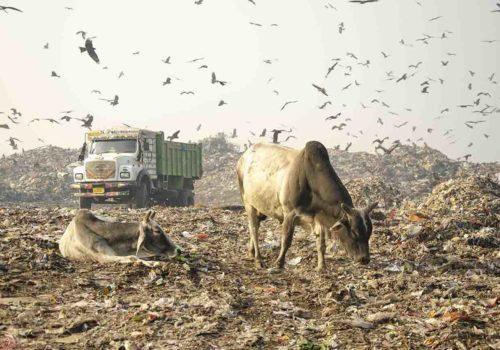This is one of the most powerful portfolios we have received.
The photographer’s name is Abhisheik Singh!
He sent us this text.
A mountain of sorts stands at the eastern end of Delhi.
Go any nearer and the ambient stench turns into a bitter realization: the mountain is but one giant heap of garbage dumped at the site called Ghazipur Dumping Yard.
Other than being a feasting ground for scores of birds and stray animals, the yard is also a source of informal employment for hundreds of scavengers who have come to settle at the base of the landfill to make a living out of the trash.
For reasons unknown, the rag pickers at Ghazipur happen to be overwhelmingly women and kids, thus outnumbering the men in the workforce. However, it is, as usual, the animals who bear the cost of mankind’s crap the most for being incognizant of the hazard they end up eating out of the endless piles of trash which is littered all over the site.
I first visited the yard in 2017 and over the years as I frequented it, awed and touched by the human factor, on a more positive note, I also got to witness the series of initiatives which are being undertaken to recycle the disproportionate amounts of waste the city is producing on a daily basis.
And in what appears to be signs of change, the dumping yard – once slated to get taller than even the Qutub Minar – has been coming down now.
The sights of garbage-burning have been replaced by giant machines put in place by the local municipal corporation as part of a bio-mining and bio- remediation project to redeem the yard.
About 20 backhoes and excavators and 15 waste separators and sieves (trammels) plying across 5 such segregation sites are working throughout the day at the yard now as opposed to nothing back in 2017 during my first visit.
Ambitious, critical and far reaching, the project seeks to segregate, recycle, repackage and supply the waste back into the working economy.
For everything riding on the project, it makes a lot of economic sense as well, for there are a range of businesses which are perennially dependent on the routine supply of the junk being segregated at the yard now, such as plastic, metals, fabric, polythene, glass, as well with various materials which will be utilized to make sanitary tiles, manure and are even being routed to the power plant.
The pipeline goal is to beautify the area and create a small ecological park ready to host even the general visitors.
By the scale and pace of it, the project could be a great example of a successful institutional and policy intervention by the local municipal body.
And while it is still in progress, there is a need to document the work, lifestyle and the challenges faced by the manpower working at Ghazipur, and further visualise them in a healthy and insightful manner to be able to highlight how a large scale recycling project such as the one Ghazipur could contribute to their overall well being by providing them employment and, more importantly better working conditions.
Through a photo series I did onsite (Ghazipur Dumping Yard) , I showed how the municipal body is employing technology and manpower efficiently to not just treat the growing problem of junk and garbage but moreover create tremendous opportunities out of difficult conditions.
Abhishek Singh
Photographs by : AbhishekSingh
Essay by : SaurabhGoyal
Abhishek Singh
https://www.facebook.com/singh.abhishek999/
https://www.instagram.com/singh_abhishek999/
https://twitter.com/er_abhishek999
Saurabh Goyal
https://www.instagram.com/mylifemywanderings/
https://mylifemywanderings.wordpress.com/contact/
https://www.facebook.com/saurabh.d21/
















